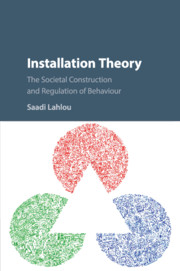Book contents
- Installation Theory
- Installation Theory
- Copyright page
- Dedication
- Contents
- Figures
- Plates
- Foreword
- Acknowledgements
- Introduction
- Chapter 1 Installation
- Chapter 2 The Problem of Human Action and the Problem of Social Regulation
- Chapter 3 Theoretical Frameworks Grounding Installation Theory
- Chapter 4 The Structure of Installations
- Chapter 5 Endurance of Installations
- Chapter 6 Selection Mechanisms in Societal Evolution
- Chapter 7 The Evolution of Installations
- Chapter 8 Redesigning Installations to Change Behaviour
- Chapter 9 Conclusion
- Glossary
- References
- Index
Chapter 8 - Redesigning Installations to Change Behaviour
Published online by Cambridge University Press: 28 December 2017
- Installation Theory
- Installation Theory
- Copyright page
- Dedication
- Contents
- Figures
- Plates
- Foreword
- Acknowledgements
- Introduction
- Chapter 1 Installation
- Chapter 2 The Problem of Human Action and the Problem of Social Regulation
- Chapter 3 Theoretical Frameworks Grounding Installation Theory
- Chapter 4 The Structure of Installations
- Chapter 5 Endurance of Installations
- Chapter 6 Selection Mechanisms in Societal Evolution
- Chapter 7 The Evolution of Installations
- Chapter 8 Redesigning Installations to Change Behaviour
- Chapter 9 Conclusion
- Glossary
- References
- Index
Summary
This section is more applicative. The examples provided in Chapters 2 and 3 showed how installation theory can be used for descriptive and analytic purposes; now we will see examples of its use in interventions.
Four examples are presented: a small-scale intervention in an academic department to foster communal activity, an intervention to increase water intake in Polish preschool children, the design of an installation for presentations in a meeting room and interventions to change social norms about incivility and violence in Colombia.
The reader who jumped directly to this chapter in the hope of getting straight to the ‘how to’ is advised to read Chapter 4 or at least Section 2.1 and Section 9.1, which are abstracts of the theory, because reading the following illustrations alone will not enable one to design interventions. It is necessary to know a minimum about the framework underlying these interventions.
Information
- Type
- Chapter
- Information
- Installation TheoryThe Societal Construction and Regulation of Behaviour, pp. 373 - 402Publisher: Cambridge University PressPrint publication year: 2018
